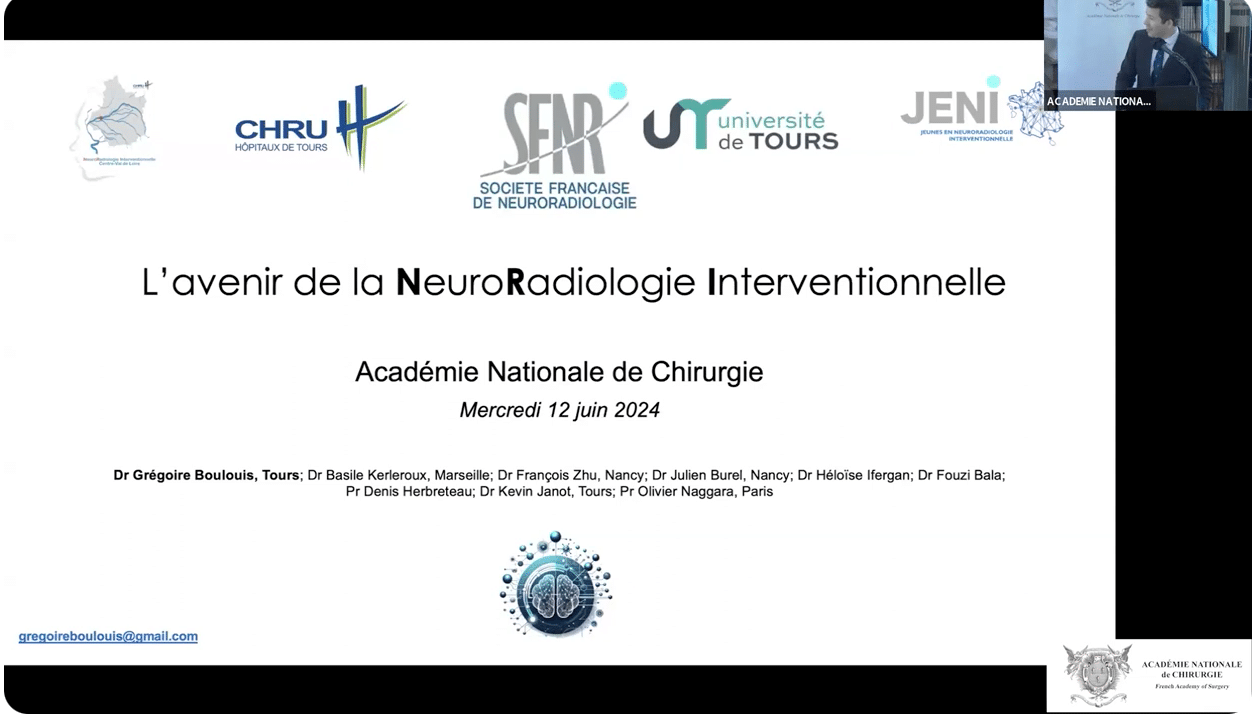Presentation given to the National Academy of Surgery by Professor Grégoire Boulouis, CHRU of Tours.
Interventional Neuroradiology (INR) has undergone profound evolution over the past few decades, becoming a cornerstone in the management of various cerebrovascular pathologies. While this specialty emerged in the 1960s and 1970s with a primary focus on preoperative devascularization of hypervascular tumors, it quickly took a major technological and therapeutic turn. Today, INR is no longer limited to preoperative procedures but has established itself as an autonomous discipline capable of treating complex central nervous system pathologies, largely thanks to spectacular technical advancements.
A striking example of this revolution is the emergence of optimized endovascular navigation systems, such as those developed by Bcv. In a context where precision and safety during procedures are paramount, Bcv stands out by designing innovative solutions that promise to transform INR practices. These technologies enable smoother and more precise navigation while reducing the risks associated with interventions, offering promising perspectives for both patients and practitioners.
A Progressive and Defining Evolution
Interventional Neuroradiology, though initially criticized during its development, has undergone a true transformation over the years. Originally conceived as a complement to traditional neurosurgical procedures, it gradually gained momentum, thanks in part to key contributions such as those from Professor Pierre Lasjaunias, who played a pivotal role in studying the microanatomy of the skull base vessels.
One of the major turning points in this evolution came in 1991 with the introduction of electrolytically detachable coils, which revolutionized the treatment of cerebral aneurysms. This advancement allowed for a gradual shift from more invasive neurosurgical interventions to less traumatic endovascular solutions, paving the way for INR to become a specialized discipline.
In 2015, another milestone was reached with the publication of the Mr CLEAN randomized trial, which demonstrated the effectiveness of endovascular treatments in managing acute ischemic stroke. Since then, INR has become an integral part of stroke management, joining other medical fields such as cardiology in the treatment of vascular pathologies.
BCV and the Future of INR: More Precise and Optimized Navigation
In this dynamic of progress, Bcv is positioned at the forefront of innovation with its optimized endovascular navigation system. Designed to provide maximum precision during interventional procedures, this system promises to make interventions safer, faster, and less invasive. With its intuitive user interface, Bcv facilitates the practitioner’s work while reducing the risk of complications.
The optimized navigation system offered by Bcv fits perfectly into the trajectory of technological advancements that have shaped the history of INR, from the early treatments of aneurysms to complex stroke interventions. This groundbreaking system is expected to push the boundaries of what is possible in INR, offering new solutions for pathologies that were previously difficult to treat.
Professor Grégoire Boulouis’ Presentation: A Glimpse into the Future
In his recent presentation in June 2024 at the National Academy of Surgery, Professor Grégoire Boulouis of the CHRU of Tours highlighted the importance of these new technologies and discussed the opportunities they offer for INR. This presentation, titled “The Future of Interventional Neuroradiology,” shed light on upcoming challenges and the technological solutions that will transform the treatment of cerebrovascular pathologies.
This engaging video, which we invite you to watch, presents the latest advancements in INR and explores how technological innovation, combined with high-level medical expertise, will lead to even more effective and less invasive treatments in the years to come.
The future of Interventional Neuroradiology thus appears brighter than ever, with systems like those developed by #Bcv heralding a new era in cerebrovascular treatments. By enhancing the precision of procedures and reducing risks, these technologies not only improve clinical outcomes but also make treatments more accessible and less traumatic for patients. Thanks to the commitment of companies like Bcv and ongoing advances in the field, INR remains a fundamental specialty for continuing to transform the management of cerebrovascular pathologies.
https://www.academie-chirurgie.fr/

